Aazokhi Waruwu
Civil Engineering Department, Institut Teknologi Medan, Medan, Indonesia
Correspondence to: Aazokhi Waruwu, Civil Engineering Department, Institut Teknologi Medan, Medan, Indonesia.
| Email: |  |
Copyright © 2014 Scientific & Academic Publishing. All Rights Reserved.
Abstract
The bamboo can be obtained easily, strong stem, resilient, straight, easy to use. The use of bamboo grid reinforcement under the foundation could increase the bearing capacity of the peat soil. The peat soil taken from Selingsing Village, District Medang Kampai, Dumai, Riau Province. The peat soil has been cleaned (sorting), compacted and saturated, and then inserted into the model box. The plate load test to obtain relationship between load and settlement. The bearing capacity of shallow foundation is very low, which can lead to building failure, especially the building above on the peat soil. The use of bamboo reinforcement of the grid layer on the foundation base will increase the bearing capacity by 140% for one layer of bamboo reinforcement, 224% for two-layer of bamboo reinforcement and 279% for 3 layers of bamboo reinforcement.
Keywords:
Peat, Bamboo, Shallow foundation
Cite this paper: Aazokhi Waruwu, Bamboo Reinforcement in Shallow Foundation on the Peat Soil, Journal of Civil Engineering Research, Vol. 4 No. 3A, 2014, pp. 96-102. doi: 10.5923/c.jce.201402.16.
1. Introduction
Peat soils have properties that are less favorable for the construction of civil buildings, because having a high water content, low bearing capability, and high compression. Peat soil is a soil containing organic matter in large quantities and thus affects the engineering properties of the soil.Peat lands in Indonesia is quite large, if the peat land in the province of Nanggroe Aceh Darussalam, North Sumatera, West Sumatera, Bengkulu and East Kalimantan are taken into account, then the total area of peat lands in Indonesia is about 21 million ha (F. Agus [1]). In general in Indonesia if build a 1-2 floor building construction over peat used cerucuk with a diameter of 10-20 cm and a length of 3-4 meters. However, the material itself cerucuk increasingly hard to come by, it would require another alternative.Peat soil has a low shear strength properties or low bearing capacity and high compression, the parameters of the weight and volume of peat soil shear strength is an important factor in the peat soil stability problems, reducing compaction, reduction of permeability, groundwater flow control, and consolidation issues. The use of cement column technique on peat soil can increase the shear strength of peat soil. Huat at. al (2011), examines the use of cement stabilization column on peat soil is not disturbed. Peat soil compaction parameters can be improved by increasing the ratio of the cement column.Kezimian et. al [2] engineering properties of peat soil can be improved with the use of sodium silica stabilization, cement stabilization, cement columns, and some other reinforcement materials. The nature of this technique has been improved, will be able to increase the bearing capacity of the peat soil. Huat [3] gives the form of peat soil bearing capacity behavior that is not reinforced foundation under construction. Large drop will occur on peat soil and lead to a settlement in foundation repair.Nugroho [4], states the addition of bamboo and geotextile grid can increase the bearing capacity of the foundation on top of the peat land bearing capacity in terms of value generated so that a bamboo grid reinforcement and geotextiles can be used as an alternative ground reinforcement materials. In general, the addition of a layer of geotextile reinforcement in the form of a bamboo grid and contribute significantly to increase the carrying capacity of the foundation.Huang and Menqs (Nugroho, [4]) to evaluate the soil under the foundation reinforcement given by a collapse mechanism proposed Schlosser et.al (Nugroho, 2011). Based on the mechanism of collapse, the two effects reinforce each other. The depth and width of foundation-slab effect, and can contribute to increase the bearing capacity.Bamboo can be obtained easily, strong stem, resilient, straight, easy to use, grows in Indonesia and grow naturally or are cultivated. Expected from the placement of a bamboo grid reinforcement under the shallow foundations, then the field will be cut off by the collapse of land retrofitting a combination of bamboo grid so as to increase the carrying capacity of the soil and lead to the foundation of the building safely.
2. Methodology
The experiment was conducted at the Laboratory of Soil Mechanics Medan Institute of Technology with burdening a model of foundation has a square cross section measuring 10x10 cm2 and 15x15 cm2, 0.5 cm thick made of iron is placed in the middle of the surface of a layer of peat soil. Peat soil taken from Selingsing Village, District Medang Kampai, Dumai, Riau Province. Peat soil has been cleaned, mixed evenly and given water prior to saturation and water content close to 200% and then compacted every 15 cm with the roller to the elevation of 90 cm, and then inserted into the model box size width 90 cm, length 120, and a height of 90 cm, which at the bottom has been given a solid layer of sand 10 cm thick (Figure 1). Foundation on top of peat ready for loading test then modeled in accordance with the established.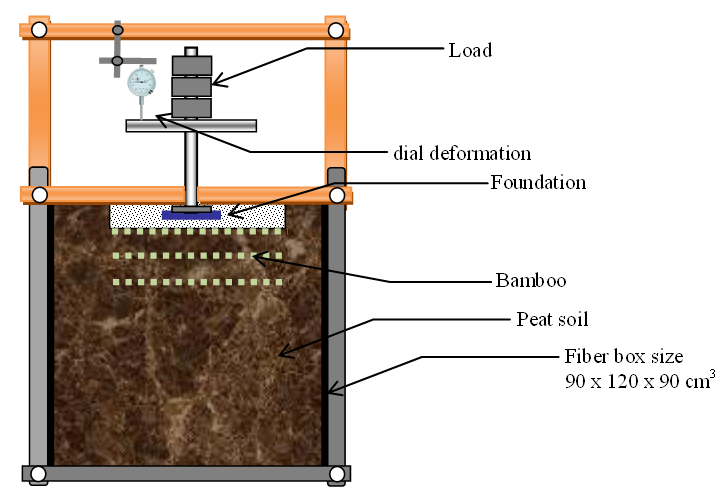 | Figure 1. Schematic model of the foundation in laboratory testing |
Model of renforcement is the bamboo grid with sides 5 cm corresponding planned configuration is placed at a predetermined depth. The top reinforcement is filled with sand that serves as the ground piled to facilitate the testing process. Foundation of a square plate with sides 10 cm and 15 cm above the layer of reinforcement placed 4 times the size of the width of the foundation by the number of layers, layer 1, layer 2 and layer 3 which has been backfilled with peat soil and then loaded using load gradually increase and each load plus one hour at 2 times the previous load. Obtained from a given load carrying capacity q, of the value of the load divided by the foundation. At the stage of loading is done so that the decrease in dial readings every variation of loading, the foundation model and the model obtained bamboo strengthening the relationship between the load and decrease. At a 10% settlement of the width of the foundation is determined values of ultimate bearing capacity of the shallow foundation (qu).
3. Results and Discussion
3.1. Physical and Geotechnical Properties of Peat Soil
Peat soil used as research material taken from the village of the District Selingsing Medang Kampai - Dumai Riau Province. From the results of preliminary tests showed that the value of specific gravity (Gs) of 1.25, the value of the volume of wet density (γb) is only 1.11 g/cm3, ash content, organic content, and fiber content respectively of 13.63%, 86, 37%, and 25.32%. Thus classified as medium ash peat-peat, peat soil with the ash content of between 5% and 15%. Peat soil with high organic content of the organic content > 75%, and fibrous peat, the peat soil with fiber content > 20%.
3.2. Behavior of Building in Peat Soil of Selingsing Village
Building a house in the location of peatlands in Selingsing village use of a simple foundation of concrete pole miniature circular, square and combination (Figure 2). Is still considered shallow foundation without the use of reinforcement layers underneath. As it is known that the peat soil has poor properties for the construction of buildings on it, such as high compression and low carrying capacity, so that the building would not be able to lightly borne by shallow foundations on top of the peat soil.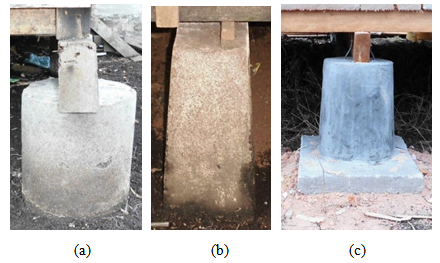 | Figure 2. Type of foundation on peat soil (a) circle pile, (b) square pile, (c) circle pile with a square footing |
The buildings house on peat soil stands on shallow foundations simple. Generally, these buildings do not last long, as shown in figure 3 some houses still intact, but the foundation is experiencing failure and tilted to the side. This is due to the unstable peat in the horizontal direction and resulted in the building tilted and do not last long. | Figure 3. Building on peat soil (a) intact, (b) will collapse, (c) failing building foundations |
3.3. Behavior Foundation Bearing Capacity Unreinforced
Plate load testing model of a shallow foundation in a laboratory show relationship load and settlement. Bearing capacity value obtained from the division of the burden of the broad shallow foundation model with square shape. The measure used is the foundation of each of 10 cm and 15 cm.Figure 4 for testing without bamboo reinforcement in foundation size of 10 cm, while the size of 15 cm are shown in Figure 5 is obtained at the expense of ultimate collapse load which resulted in 10% reduction in the width of the foundation (Terzaghi and Peck). Ulltimit bearing capacity generally increases as the dimensions of the foundation. Of three dimensional foundation selected value of the average carrying capacity of the foundation on top of a layer of peat obtained at 0.0185 kg/cm2. If the addition of a layer of sand under the basic foundation bearing capacity obtained by increasing the value of 0.0193 kg/cm2 (up 4.32%). | Figure 4. Bearing capacity of squares foundation width of 10 cm unreinforced |
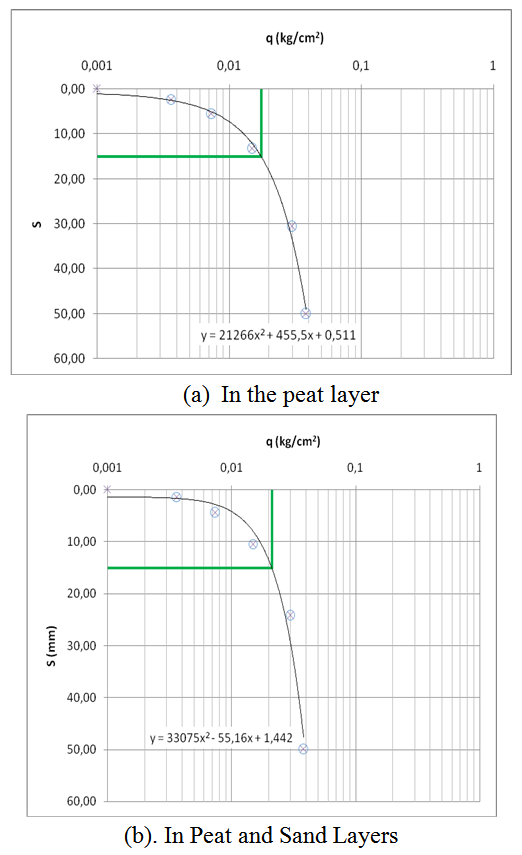 | Figure 5. Bearing capacity of squares foundation width of 15 cm unreinforced |
Foundation bearing capacity on the peat layers obtained for the 10 cm width of the foundation of 0.0252 kg/cm2 to 15 cm in diameter and 0.0175 kg/cm2 average is 0.0213 kg/cm2.
3.4. Behavior Bearing Capacity of Shallow Foundations Due to Bamboo Reinforcement
Model testing of shallow foundations on top of the peat soil with dimensions of 10 cm and 15 cm showed the value of soil bearing capacity (q, kg/cm2) in 10% reduction of the width of the foundation (collapse load). Ultimate bearing capacity obtained from a 10% reduction in load on the foundation width divided by the area of the foundation. Relation to load a log scale with a decrease in the size of 10 cm width of the foundation can be seen in Figure 6 and Figure 7 bearing capacity values.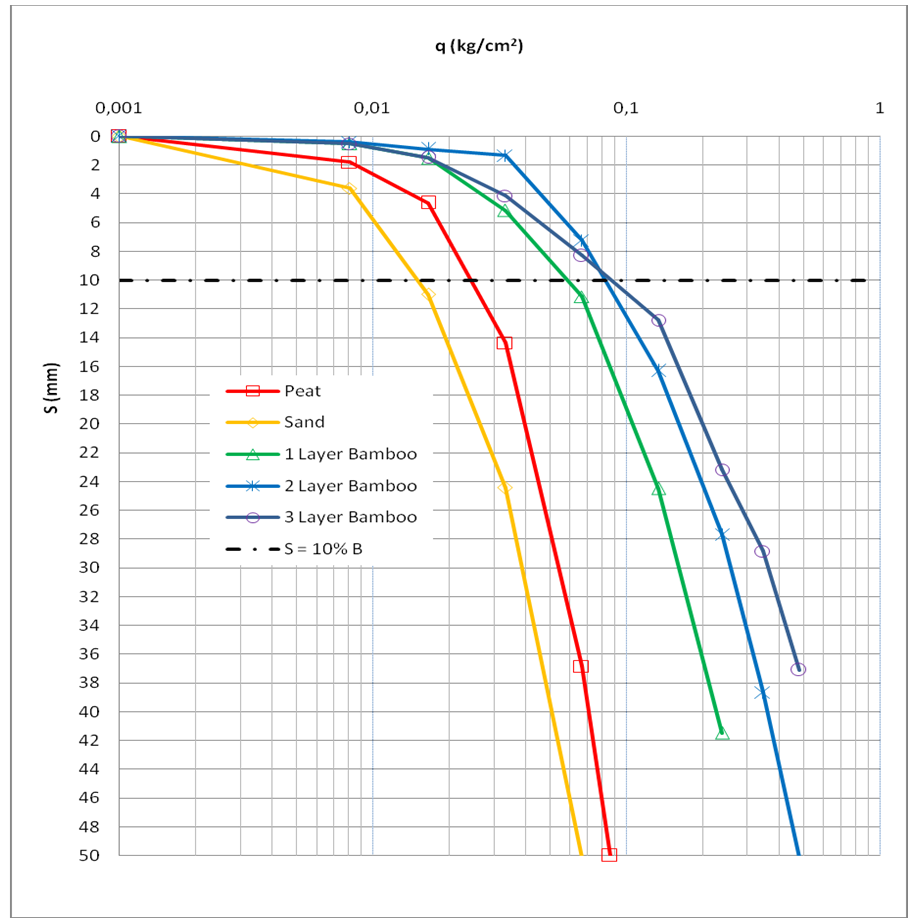 | Figure 6. Relationship with the decline in the bearing capacity of the foundation with a width of 10 cm |
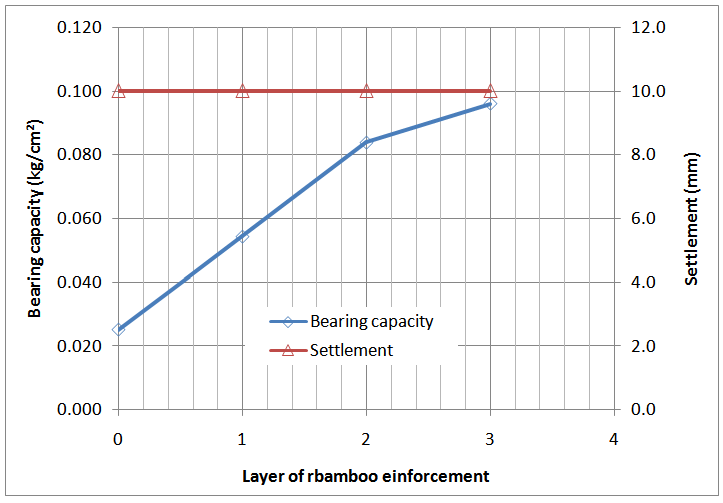 | Figure 7. Ultimate bearing capacity of foundation with foundation width 10 cm |
Ultimate bearing capacity values at the foundation of a size of 10 cm (Figure 7) increased after given reinforcement layer 1, layer 2 and layer 3. Significant increases occurred in the number of reinforcement layers 2 layers.The behavior of the relationship between the load and a decrease in the size of 15 cm foundation testing, shown in Figure 8: The bearing capacity of the foundation at the time 10% reduction in the width of the foundation is increasing in line with the increase in the number of layers of bamboo grid reinforcement (Figure 9).Utilization of bamboo as reinforcement ply direct significant impact on a bamboo grid reinforcement layer. If the carrying value seen when the 10% decline foundation width (Figure 8). Bearing capacity value increased sharply after the installation of the reinforcement layer. For the 15 cm width of the foundation, the increase in the value of the bearing capacity of 0,018 kg/cm2 to a carrying capacity of 0,048 kg/cm2 (for a single layer of bamboo grid). Changes in the value of the largest bearing capacity occurs in the use of a single layer of reinforcement, whereas for two-and three-tier increase is not much as before. | Figure 8. Relationship with the decline in the carrying capacity of the foundation with a width of 15 cm |
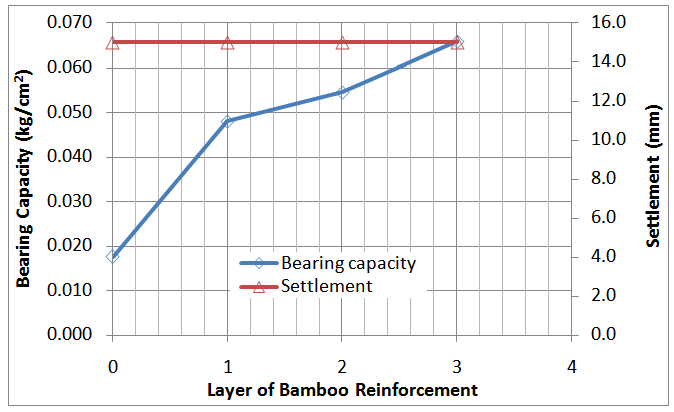 | Figure 9. Power of ultimate bearing foundation with foundation width 15 cm |
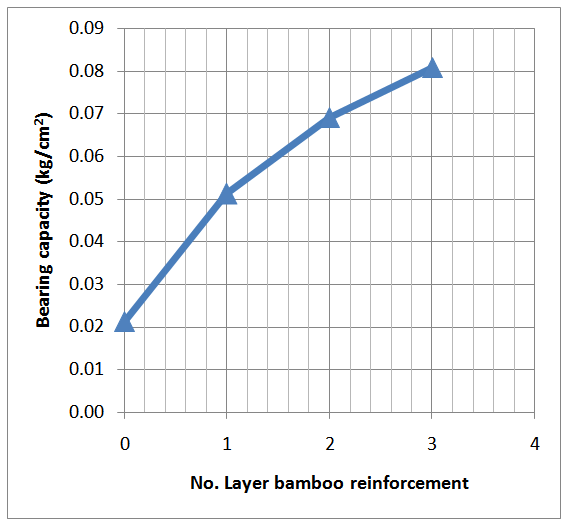 | Figure 10. Increased foundation bearing capacity with bamboo reinforcement |
3.5. Bamboo Benefits Increased Capability against Shallow Foundations
Bearing capacity value on the test results with the foundation 10 cm wide and 15 cm are shown in Table 1 Value of the foundation bearing without retrofitting of only 0.0213 kg/cm2. After retrofitting bamboo utilization increased 140% for one layer of reinforcement, 224% for two-layer grid bamboo and 279% for the retrofitting of 3 layers of bamboo grid. This increase gives the meaning that the burden can be borne by the foundation on peat soil can be increased up to 279% on the same foundation size or the same load, can save approximately 279% foundation dimensions.Table 1. Bearing capacity Foundation value without and with Reinforcement
 |
| |
|
4. Conclusions
Building on top of the peat soil will collapse sooner, if using shallow foundation without reinforcement. From modeling in laboratory test results demonstrate the value of shallow foundation bearing capacity is very low without reinforcement. It can be a factor of building failure.Utilization of bamboo reinforcement of the grid layer will increase the bearing capacity by 140% for one layer of reinforcement, 224% for two-layer grid bamboo and 279% for the retrofitting of 3 layers of bamboo grid. This increase gives the meaning that the burden can be borne by the foundation on peat soil can be increased up to 279% on the same foundation size or the same load, can save approximately 279% foundation dimensions.
References
| [1] | Agus F., Made S.I.G., 2008, Soil Research Institute and the World Agroforestry Centre (ICRAF), Bogor. |
| [2] | Kazemian Sina dkk, (2011), A state of art review of peat: Geotechnical engineering perspective, International Journal of the Physical Sciences Vol. 6(8), pp. 1974-1981, 18 April, 2011. |
| [3] | Huat Bujang B. K., et al. (2011), A study of the compressibility behavior of peat stabilized by DMM: Lab Model and FE analysis, Academic Journals, Vol. 6 (1), pp. 196-204. |
| [4] | Nugroho S.A, 2011, Studies on the Carrying Capacity of Shallow Foundations with the combination of Peat Soil Geotextile and Bamboo Grid, Journal of Civil Engineering Vol. 18 No. 1: 13-40. |











 Abstract
Abstract Reference
Reference Full-Text PDF
Full-Text PDF Full-text HTML
Full-text HTML